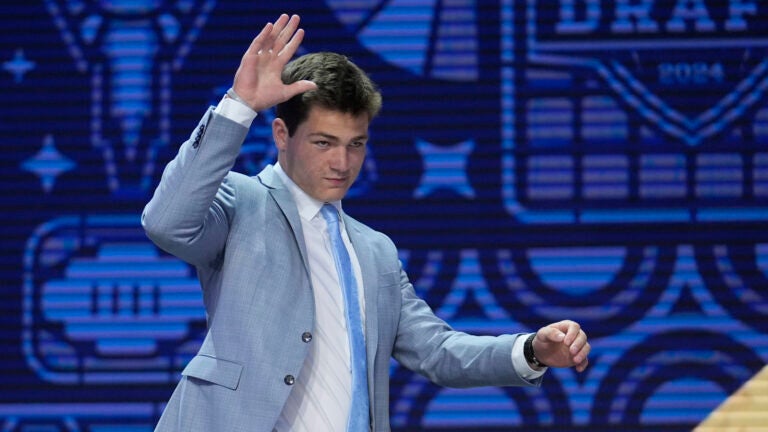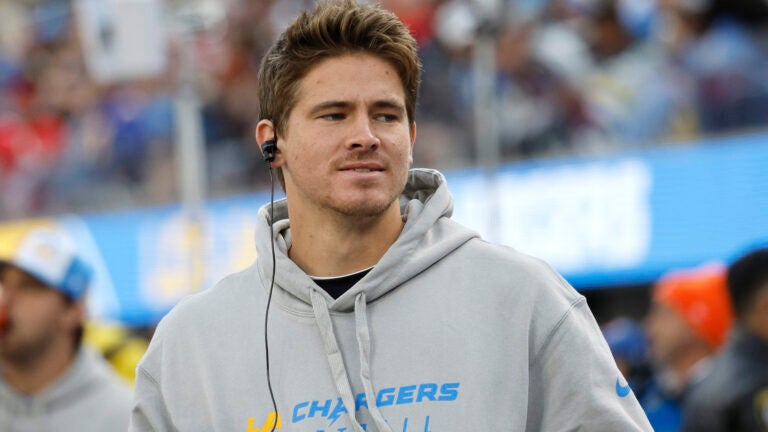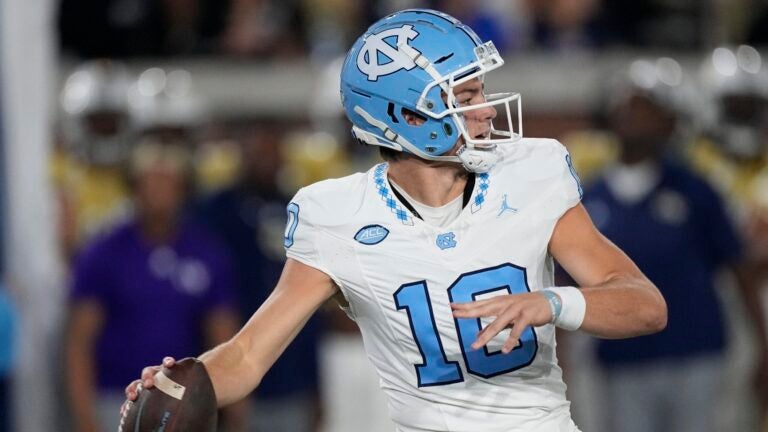Carsen Edwards has always played with an edge

Carsen Edwards is a bucket-getter.
He showed it as a senior at Atascocita High School in Texas, when he reached 50 points in his last district game. He showed it as a junior in college, when he scored 42 points in Purdue’s overtime loss to Virginia in the Elite Eight of the NCAA Tournament. And he showed it as an NBA rookie, when he knocked down eight 3-pointers in the Celtics’ preseason finale.
“I don’t know if I’ve ever seen anything like that,’’ coach Brad Stevens said after the latest performance. “Those were deep, hard 3s — and how many? Eight? In, like, five minutes? I’ve never seen anything like that.’’
For those who have previously coached Edwards, the showing garnered smiles and laughs. They’ve seen Edwards ball out just like that, fully expecting him to do it again and again.
“I mean, he was instant offense,’’ his high school coach David Martinez said. “Even when he misses, when you watch him shoot, the ball looks like it’s going in.’’
The buckets are the result of Edward’s tireless effort to become a tough-nosed basketball player. So much so that he’s become the standard for two of his former coaches. Kingwood’s Monte Cole, a former Atascocita assistant, and Purdue’s Matt Painter both asked their respective teams this year if anybody worked harder than Edwards during the offseason.
“His work ethic was second to none for any kid that I’ve been around,’’ Cole said. “He doesn’t roll out of bed and he’s this great shooter. It doesn’t just happen. He put in a lot of work.’’
‘Built like a tank’
When Cole first met Edwards, two things stood out: the size of his hands and the size of his feet. “Huge,’’ Cole said. Edwards wasn’t very tall, measuring at approximately 5 feet 6 inches as a 14-year-old freshman. What he initially lacked in height, however, he accounted for in his sturdy build, which some likened to that of a running back.
“He’s wound up really tight,’’ Martinez said. “He’s just built like a tank. When you add that type of body to the speed and power he has, he can slice through defenses, his body can take contact, he can finish at the rim, and he’s got some explosiveness to him.’’
Edwards earned a reserve role on the varsity team his freshman year at Atascocita, though he didn’t receive much playing time. Often the third guy off the bench, he averaged no more than 8 points per game, Martinez recalled.
As a sophomore, Edwards decided to join his older brother, Jai, and play football during the fall. He was a backup receiver on the varsity team (and would have started had he returned as a junior). But when the football team’s playoffs wrapped up after basketball season had already started, Martinez relegated Edwards to junior varsity.
The short-lived demotion was intended to give Edwards an opportunity to get live reps before rejoining the varsity squad, Martinez said. Edwards still wasn’t a fan, regardless of the reasoning. To this day, he says he doesn’t understand the rationale behind the decision, but he does recognize its “life-changing’’ impact.
“It just lit a fire under me to kill everybody, really,’’ Edwards said. “I wanted to make our coach look not very smart for doing that. I wanted to kill every player that was on varsity ahead of me. I wanted to kill every person in our district. I wanted to kill every person in our state. I wanted to kill every person in our country. It went all the way down the line.’’
Edwards called the demotion a “wake-up call,’’ one that transformed his work ethic. Moving forward, he had two requests: 1. Unlock the door to the gym at 5:30 a.m. every morning. 2. Leave a couple of basketballs.
“I’m just going to work,’’ he said. “I’m not going to say anything. I’m not going to ask for another chance. I’m not going to do any of that. I’m just going to work and work. I’m not going to talk about anything. I just realized I’m going to have to fight, I’m going to have to kill.’’
Every morning, Edwards would employ a shooting machine to “hone his craft.’’ If it was 5:31 a.m. and the gym was locked, phones would be ringing. He was on a mission.
“From that point on, he wanted to prove to me that I made a mistake, that I shouldn’t have moved him down,’’ Martinez said. “He really wore out the gym.’’
The individual sessions paid off, as did hours spent in the weight room. At 16 years old, Edwards was bench-pressing at least 200 pounds and squatting 300, Cole estimated. Although he quit the football team, he continued to use that experience to his advantage.
“He plays with that football mentality,’’ said assistant coach Jerel Orr. “He’s extremely aggressive, he’s extremely physical, and he uses that to his advantage. He works hard in the weight room to make sure he’s ready to deal out the punishment.’’
With increased strength came a higher and quicker release. Everything came together on the court, where he nabbed the majority of the program’s shooting competition records in practice and racked up 25-plus points in several games. Perhaps the most memorable outing was when he scored 13 straight three-pointers in the team’s last district game his senior year. During a break, Martinez overheard one of his players tell Edwards his point total through three quarters. The reply? “I’m going for 50.’’
“If he said he was going to do something, he went out and did it,’’ Martinez said. “He got 50 with three minutes to go in the game. He probably would have had 60 if I would have left him in.’’
The Purdue years
The college recruiting process was challenging for Edwards, as several coaches shared concerns about his size and his position as a high-volume shooting point guard. Mid-major schools in Texas, like Rice, Southern Methodist University, Houston, and Tulsa, expressed interest, but Edwards wanted to play for a high-major program.
His ability to shoot caught the attention of Purdue men’s basketball coach Matt Painter, who brushed aside those worries.
“Carsen’s really a 5-foot-11 scoring guard, but if you take the things that he does, he plays a lot bigger than 5-foot-11,’’ Painter said. “He’s got big hands, he’s got long arms, [and] he’s got a quick release on his shot.’’
Similar to his high school career, Edwards’s role at Purdue grew with each season. After his freshman year, in which he shot 38.2 percent from the field and averaged 10.3 points, he reached out to “the shot doctor’’ Joey Burton because he wanted to improve his field goal percentage. Burton’s first focus was getting Edwards to not jump as high in order to create more of an arc on his shot.
“If you jump really high on your jump shot, players can have the tendency to shoot on the way down rather than on the way up,’’ Burton said.
Once Edwards got the feel for his re-tooled motion, Burton said he never shot a normal three again. Instead, they practiced from deeper range, like 27- and 28- feet away. “Shooting further, you’re usually going to be a little bit more open,’’ Burton explained.
In addition to their work on the court, Burton watched a lot of film with Edwards, namely tape featuring point guards Kemba Walker and Damian Lillard. When Walker signed with the Celtics after Edwards was drafted, the two shared a chuckle. Lillard, though, holds the throne as Edwards’s favorite player.
“He gets after it,’’ Edwards said. “Obviously, in the NBA, you have to have that edge. Everybody has that edge. But his to me is like a silent-type edge, where he’s not just talking. You know, he’s a killer. He makes it look easy.’’
Edwards’s time at Purdue culminated with a junior season in which the Boilermakers were seconds away from a Final Four berth in the NCAA tournament. He broke the single-tournament three-point record with 28, started all 36 games, and averaged 24.3 points that season.
While the run was undoubtedly impressive, what stood out more to Burton was Edwards’s relentlessness throughout the year. In the final minutes of a 1-point loss to Florida State in November, Edwards missed a pair of critical free throws. When the team returned to campus at 2:30 a.m., he went right to the practice facility to work on just that: Edwards didn’t go to bed until he made enough free throws to “feel right.’’
“I felt like the game was on me,’’ Edwards said. “I felt like I could have won it for us. I hate losing in general, but then having a feeling the game was in my hands in a way and I wasn’t able to convert, it makes it harder for me to sleep.’’
“He made like 200 free throws,’’ recalled Burton. “It was just him, late at night, in the gym. He just kept working. That’s who he is. When things aren’t going his way on the court, he doesn’t give in.’’
‘He plays really hard’
Now in the NBA, Edwards is still undersized. His practice shorts have jagged edges because he cuts them in favor of a shorter length.
“I’m not that tall,’’ Edwards said. “Basically every piece of NBA gear is made for tall people. Any shorts that fit me waist-wise are still going to be long for me.’’
Although he strives to be an assassin on the court, Edwards is also known for being exceedingly polite in practice, a function of his upbringing. He always addressed Burton as “sir,’’ just how he calls new Celtics assistant coach Kara Lawson “ma’am.’’ He’s thoughtful in conversations, eager to hear feedback and ensure he has things right.
“When you talk to him about something, he thinks about what you’re saying,’’ Lawson said. “You know how some people just are already waiting for you to finish talking so that they can answer you? You can see he’s listening to what you’re saying.’’
After a couple of months working with Edwards, Lawson likes what she sees from the 21-year-old rookie, highlighting three of his core traits: his ability to change speeds, his explosiveness, and his tremendous range. His eight threes in the preseason finale came as no surprise; in fact, she expects more nights like that.
“The thing I like about Boog the most is he’s not afraid,’’ Lawson said. “I love his confidence. I love his fearlessness. He just has this mentality that he’s going to go after people and he’s going to make shots.’’
The two have been working on getting Edwards up to speed on the team’s schemes, which includes watching a lot of film. Their focus is on more than just his shot, putting an emphasis on the defensive end as well.
“I want my ability to shoot to be well-known, but I just want to be known as someone that plays really hard,’’ Edwards said. “That’s what I want people to know, like Carsen Edwards, he plays really hard. He’s not an easy player to play against.’’







